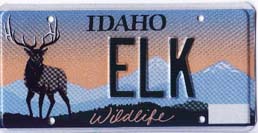The interest group, Sportsmen for Fish and Wildlife-ID was complaining about these plates. Later Nate Helm, their E. D. posted, saying SFW-ID just wanted to make clear the plates do not provide support for hunted wildlife — “game.”
Yes, and Idaho Fish and Game just put out a news release indicating so. I would urge Idahoans to buy the plates, and buy a hunting or fishing license too, even if you don’t hunt or fish because that helps wildlife too. Ralph M.
– – – – – –
Idaho Fish and Game Headquarters News Release
Boise, IDDate: January 8, 2007
Contact: Ed Mitchell
(208) 334-3700Wildlife [license] plates help support nongame wildlife programs
More than 80 percent of Idaho’s wild creatures-523 species including songbirds, waterbirds, raptors, small mammals,reptiles and amphibians, and threatened and endangered wildlife-are classified as “nongame wildlife.”
Nongame wildlife is not normally hunted, fished or trapped, but is found in every corner of Idaho. Robins in our backyards, the elusive wolverine of Idaho’s high mountain ranges, pygmy rabbits in the sagebrush deserts, and frogs in Idaho’s wetlands are just a few of our nongame animals.
Formal funding of the Idaho Department of Fish and Game’s nongame wildlife program began when the Legislature approved a state income tax check-off on the 1981 tax form, which still continues as an important source of program income today.
In 1992, the Idaho Legislature passed the wildlife license plate bill that allowed a portion of the wildlife license plate proceeds to benefit the nongame wildlife program.
The bluebird plate became available in 1993. The elk plate was added in 1998 and the cutthroat trout plate in 2003. Wildlife plates are available at the vehicle licensing offices of every county assessor. Of the $35 special plate fee, the nongame wildlife program gets $25 from the purchase of a new bluebird plate, and $15 from each annual plate renewal. The elk and trout plates bring in slightly less because they also support elk disease research and non-motorized boating access, respectively.
The nongame wildlife program receives no money from the sale of hunting and fishing licenses and tags and no general tax funds from the State. The wildlife plates provide about 95% of state-based nongame wildlife program funding, helping to pay for projects like annual bald eagles counts and the new Idaho Birding Trail as well as the Project WILD and Wildlife Express conservation education programs for teachers and students.
Wildlife plate funds also provide critical matching dollars for federal grants and partnerships with federal natural resource agencies.For information, or to buy a wildlife plate contact the local county assessor:http://itd.idaho.gov/dmv/vehicleservices/assessor.htm; or the Department of Transportation Special Plates-Registration Services Section on the Internet at http://www.itd.idaho.gov/dmv/Vehicleservices/registr.htm; or by phone at
208-334-8649.– – – – – – – – – – – –

Comments
Buying a federal Duck Stamp is also a great way to directly contribute toward conservation. Duck Stamp revenue is used to buy land, especially wetland additions to national widlife refuges. For more details: http://www.fws.gov/duckstamps/